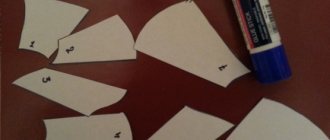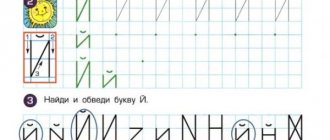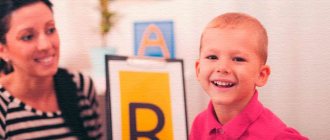Psychological lesson. Topic “We are all so different” lesson plan (senior group)
Author: Kunavina Larisa Yuryevna, teacher of the combined type MADOU “Kindergarten No. 9”, Bogdanovich, Sverdlovsk region
Psychological lesson. Theme: “We are all so different”
Goal: creating a favorable psychological climate in the children's team, developing empathy in children, developing positive communication skills in children, increasing children's self-esteem, harmonizing their internal state, developing children's understanding and feeling for each other.
Materials for the lesson: musical accompaniment, pebbles, a large and small sun according to the number of children, blots, a trash bin.
Progress of the lesson.
Stage 1 - greeting. Exercise “Palms”.
Each child needs to introduce themselves. The first child places his palms on the table and says his name. The next child places his palms on the palms of the previous child and also says his name, etc. As a result, a tower of palms is formed.
Some children are embarrassed to say their name, but over time they overcome their shyness. The exercise helps bring children together.
Exercise “Sprout under the sun.”
Children turn into a small sprout (they curl up into a ball and wrap their arms around their knees), the sun warms up more and more often, and the sprout begins to grow and reach for the sun.
All movements are performed to the music.
Stage 2 - the ritual of “entering” a fairy tale.
Children sit in a circle. They stretch out their palms to the magic ball and close their eyes. They say the words: “One, two, three – come into a fairy tale!”
Stage 3 – reading the fairy tale “Rose and Chamomile”. (Text of a fairy tale from the book by O.V. Khukhlaev, O.E. Khukhlaev. Labyrinth of the Soul. - M.: Academic Project, 2010).
Now I will tell you the fairy tale “Rose and Chamomile”.
“In a small town without a name there was a tiny garden in which a beautiful scarlet rose grew. Not far from her grew a poor defenseless chamomile. It had just blossomed; its petals, which had not yet matured, were white and ordinary. The chamomile was surrounded by many wildflowers. But nothing made her happy. In her tiny head there was a big dream - to become a beautiful, unusual flower. Chamomile looked with admiration at the well-groomed rose. When there was a drought, the owner watered his flower. When it rained, the rose was covered, and not a single menacing drop fell on the velvet petals of the delicate flower. “How good she feels,” thought the chamomile. “I wish I could be in her place,” a small yellow flower with long petals like butterfly wings never stopped dreaming.
But one day a little boy was walking along the path. Seeing the chamomile, he said with admiration: “What a beautiful flower!” At first Chamomile could not understand these words; until that moment she considered herself the ugliest plant. The kid explained to the chamomile that all flowers are good in their own way.”
Discussion of a fairy tale.
1. Why did the daisy look at the rose with admiration?
2. What does it mean “all flowers are good in their own way”?
3. Can this phrase be said about people?
Every person is good in their own way. We are all different: we have different appearance, voice, character. Nowhere, nowhere on the planet is there such a baby as you, there is no such wonderful girl (like ....), there is no such cheerful boy. You are the only one in the world, there is no other child like you.
Let's now try to compliment each other.
- What is a compliment? (children's answers). Yes, you are absolutely right, a compliment is kind, pleasant words spoken to someone. When giving a compliment, they try to talk about the person’s positive traits. What positive qualities does a person have?
Stage 4 – Communication game “Give a pebble”
Take one pebble from the box and give it to whomever you want, but always with the words: “I’m giving you this pebble because you’re the one...” To those children who have nothing left, the presenter gives the pebbles, but always making a note the best qualities of each child to whom he gives a gift.
Stage 5- Psycho-gymnastics “Glue rain”
— Guys, do you like to walk in the warm rain? While we were talking, a gentle rain began to fall. (Children jump joyfully to the music in imaginary rain). The music stops.
— The rain turned out to be not simple, but glue. He glued us together. Sit in a circle on the carpet and hold hands. “Warmth” will go from me to the right, that is, I will gently shake Sasha’s hand, he will shake the next one, and so on in a circle. Let's try. And now do the same thing, but with your eyes closed. Let's see how the group works together.
Stage 6 – Game “We swear at vegetables and fruits”, Game “Trash can”.
Well, the rain has stopped and we can move freely. While we were walking in the rain, we found ourselves in a clearing. There are rude, angry, angry people gathered here who are always swearing, arguing, fighting and calling names. They turned into scary faces and blots. Let's help these people become kinder and more cheerful, and for this we will teach them to swear cheerfully.
Game “We swear at vegetables and fruits”
Children are invited to stand in a circle and scold those standing next to them with a vegetable or fruit (you are a tomato, and you are an orange). It is advisable to pronounce these words angrily, angrily. These actions cause laughter. “You see, we started laughing, and I don’t want to say bad words anymore.”
Garbage Bin Game
Let's get rid of the embodiment of cruelty and anger.
Children are invited to tear into small pieces sheets of paper depicting scary faces and dirty blots. Then trample the anger under your feet, and put the scraps in a garbage bag, tie the bag, and throw it in the trash.
Guys, you and I have spent so much energy with rudeness, anger, malice, so let's take a rest.
Stage 7 – Relaxation game: “In the clearing”
“Imagine a forest clearing in which soft grass grows. Lie on her like a feather bed. Everything around is calm and quiet, you breathe evenly and easily. A wildflower bows its head above you, you can hear the singing of birds, the chirping of grasshoppers. You feel the gentle rays of the sun stroking your cheeks. A gentle breeze tickles you. Whoever feels it opens his eyes.
All this time the sun was watching you. See how it smiles wide for you. Let's smile wide and wide at the sun.
The sun gives you gifts (little suns).
-What can you do with the sun? (children’s answers: “Give to a friend. Draw a smiling face. Tie a string - it will be a kitten toy or a medallion. Make an applique.”)
Stage 8 – generalization of the acquired experience.
The results of the lesson are summed up, the sequence of what happened is recalled, the merits of individual children are noted, the significance of the acquired experience and its connection with real life is emphasized.
Stage 9 – the ritual of “exiting” the fairy tale.
Children sit in a circle. They stretch out their palms to the magic ball and close their eyes.
Teacher: “You can take with you all the most important things you learned in class. One, two, three – get out of the fairy tale!”
Pedagogical project “We are so different, and we are together”
- August 15, 2015
Conference “Project activity in an educational institution - 2015”
Nomination “Pedagogical project in a preschool institution”
The individual characteristics inherent in each child, a different approach to raising children at home, are the basis of an emerging personality with its own interests, inclinations, and desires. In a group of children, it is important to preserve the individuality of each child, and at the same time organize the educational process in such a way that each child feels like part of a small cell of society - a group, with its own foundations, rules and norms of behavior
Project participants are teachers, middle group children (4-5 years old) who have returned to kindergarten, and their parents.
Project type : pedagogical.
The scale is long-term.
Problem. In the coming year, four-year-old children will join our group. The child's upcoming visit to preschool brings many changes to his life: first of all, the absence of parents and close people; requirements of the daily routine established in kindergarten; rules and norms of behavior that you need to get used to; contacts with peers, each of whom is already an individual with his own desires and habits; a new room containing a lot of unknowns, and therefore potentially dangerous; a different style of communication between adults and the group of children in the group.
The older the children, the longer the adaptation period stretches and the more difficult it is to get used to the new environment.
This project is based on the lesson system of the manual for practical kindergarten workers “Let's get to know each other! Training development and correction of the emotional world of preschoolers 4-6 years old,” author-compiler I.A. Pazukhina.
Project goal: Children’s mastery of the world of feelings through knowledge, the ability to recognize and handle them, and the development of free communication. Creating conditions for children to learn the rules of communication and interaction with other people, familiarizing them with basic norms and rules of relationships
Project objectives:
- Development of skills of self-control and self-analysis, attention to oneself, to one’s experiences and desires; the ability to distinguish between your individual characteristics, your muscular and emotional sensations.
- Development of skills for joint activities, a sense of community, understanding the individual characteristics of other people; developing an attentive attitude towards people and each other; development of sign language, facial expressions and pantomime; understanding that there are other means of communication besides speech.
- Getting to know a person’s emotions, recognizing one’s emotions, recognizing the emotional reactions of others and developing the ability to adequately express one’s emotions.
- The child’s awareness of his place in the family and understanding of intrafamily relationships; awareness of oneself as a full, accepted and loved member of the family.
- Involving parents in the educational process, uniting the child-parent team of the group.
Age of children for whom the project is designed: children of middle preschool age (4-5 years) and their parents.
The implementation period is from September 15, 2014 to May 29, 2015.
Strategy to achieve the goal
The implementation of the assigned tasks will take place in stages. Each stage involves 3 stages:
Stage I – Organizational.
Identification of the level of the emotional-volitional sphere of children, the child’s ideas about himself and his immediate environment. Selection of games, play exercises, methods and forms of working with children. Selection of works of fiction, pictures, didactic and visual material for organizing educational work. Development of advisory material for parents. Developing a plan for working with children, coordinating planned activities with the kindergarten administration and the second teacher of the group. Distribution of responsibilities between teachers.
Stage 2 – Main (content part)
1. Pedagogical education of parents about the development of the emotional, volitional sphere, about the characteristics of the personal development of children 4-5 years old. Involving parents in the process of children’s development: meetings with interesting people, preparation of children’s presentations “My name”, “What I love”, etc.
2. Development of the emotional-volitional sphere of children.
The implementation of the set goals and objectives will take place throughout the academic year. The main educational unit will be educational situations conducted at different regime moments. Form of organization – group and subgroup. All routine moments will be involved: morning reception of children, time before breakfast, after classes before a morning walk, after a walk before lunch, after a nap, after an afternoon snack, before dinner.
The pedagogical process will be carried out in the process of joint activity of an adult and children during characteristic types of children's activities (play, communicative, labor, productive, reading).
A special place in the organization of children will be occupied by: play, communication with adults and peers, object-based, visual, artistic and theatrical activities, and child labor.
It is actively planned to use play motivation in organizing children's activities. All types of educational situations conducted will take place either in the form of a game or composed of game techniques and actions. Preference is given to visual, gaming and practical methods. The teacher’s words are accompanied by various forms of visualization and practical activities of children.
Since children of this age are experiencing an awakening interest in the rules of behavior, the main thing for the teacher is to anticipate the actions of children and orient them in advance to correct behavior. Therefore, among educational techniques, a large place belongs to the personal example of the teacher, as well as projective assessments - assessments for the expected future correct actions of the child.
The active development and maturation of the emotional sphere allows the teacher to direct his efforts to awakening the emotional responsiveness of children.
Stage 3. Final
Target. To identify the level of emotional competence of middle preschool children. Analyze the results of the project. Develop a project on the social development of children for the next year.
Analyze the involvement of parents and children in the process of working together.
Project products: child-parent newspapers, presentations: “My favorite activities”, “What I like and don’t like to eat”, “My name”, an album with photographs of children in different emotional states “We are different”, stand “Our moods”, TV game “Our Rules”, icons depicting prohibitions and recommendations for the behavior of children in a group
Expected results. The result of the implementation of this project will be the preservation of the individuality of the children of the group, the disclosure of the personal characteristics of each; development of skills for joint activities and a sense of community.
Annex 1
Educational and methodological plan of the program
Stage I (children 4 – 5 years old)
| Chapter | Lesson topic | Number of classes |
| "Me and my features" | "My name" | 1 |
| "Self-Portrait" | 1 | |
| "My inner world" | 1 | |
| "My family" | 1 | |
| "We are so similar. We are so different" | 1 | |
| "My Helping Hands" | 1 | |
| "My ears are my helpers" | 1 | |
| "My favorite toy" | 1 | |
| "Me and my emotions" | "Joy" | 2 |
| "Astonishment" | 1 | |
| "Fear" | 2 | |
| "Anger" | 1 | |
| "Resentment" | 1 | |
| "Our Emotions" | 2 | |
| "Me and others" | "Boys and Girls" | 1 |
| “If someone is crying nearby” | 1 | |
| "In the play corner" | 1 | |
| "Let's live in peace" | 1 | |
| "Different actions" | 1 | |
| "Treat" | 1 | |
| "On a walk" | 1 | |
| "I know, I can, I can" | 2 | |
| "Our group. What we can do" | 2 | |
| Total: | 28 lessons | |
Appendix 2. Project “We are so different, and we are together.”
Author: Olga Aleksandrovna Garbovskaya, senior teacher of NDOU Kindergarten No. 414 of JSC Russian Railways, Perm.







